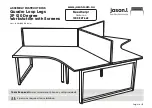
WARNINGS:
Use electrosurgery with caution in the presence of internal or external devices such as
pacemakers or pulse generators. Interference produced by the use of electrosurgical devices can
cause devices such as pacemakers to enter an asynchronous mode or can block the pacemaker
effect entirely. Consult the device manufacturer or hospital Cardiology Department for further
information when use of electrosurgical appliances is planned for patients with cardiac
pacemakers or other implantable devices.
If the patient has an Implantable Cardioverter Defibrillator (ICD), contact the ICD manufacturer for
instructions before performing an electrosurgical procedure. Electrosurgery may cause multiple
activation of ICDs.
Do not use electrosurgical equipment unless properly trained to use it in the specific procedure
being undertaken. Use by physicians without such training has resulted in serious, unintended
patient injury, including bowel perforation and unintended, irreversible tissue necrosis.
For surgical procedures where the high frequency current could flow through parts of the body
having a relatively small cross-sectional area, the use of bipolar techniques may be desirable to
avoid unwanted coagulation.
For all Monopolar modes, any associated equipment and active electrodes must be rated to with
stand the combination of output voltage, vp-p and crest factor as stated in this manual.
In some circumstances, potential exists for alternate site burns at points of skin contact (e.g.,
between the arm and the side of the body). This occurs when electrosurgical current seeks a path
to the return electrode that includes the skin-to-skin contact point. Current passing through small
skin-to-skin contact points is concentrated and may cause a burn. This is true for grounded,
ground referenced, and isolated output generators.
To reduce the potential for alternate site burns, do one or more of the following:
• Avoid skin-to-skin contact points, such as fingers touching leg, when positioning the patient.
• Place 5 to 8 cm (2 to 3 in.) of dry gauze between contact points to ensure that contact does
not occur.
• Position the return electrode to provide a direct current route between the surgical site and
the return electrode which avoids skin-to-skin contact areas.
• In addition, place patient return electrodes according to the manufacturer’s instructions.
Potential for alternate site burns increases if the return electrode is compromised. Bovie
recommends the use of split return electrodes and Bovie generators with a contact quality
monitoring system.
The entire area of the neutral electrode should be reliably attached to the patient’s body and as
close to the operating field as possible.
The cables to surgical electrodes should be positioned in such a way that contact with the patient
or other leads is avoided. Temporarily unused active electrodes should be stored so that they are
isolated from the patient.
Do not wrap the accessory cords or return electrode cords around metal objects. This may induce
currents that could lead to shocks, fires, or injury to the patient or surgical team.
The use of flammable anesthetics or oxidizing gases such as nitrous oxide (N2O) and oxygen
should be avoided if a surgical procedure is carried out in the region of the thorax or the head,
unless these agents are sucked away.
Non-flammable agents should be used for cleaning and disinfection wherever possible.
Flammable agents used for cleaning or disinfecting, or as solvents of adhesives, should be
allowed to evaporate before the application if HF surgery. There is a risk of pooling flammable
solutions under the patient or in body depressions such as the umbilicus, and in body cavities
such as the vagina. Any fluids pooled in these areas should be mopped up before HF surgical
equipment is used. Attention should be called to the danger of ignition of endogenous gases.
Some materials, for example cotton, wool and gauze, when saturated with oxygen may be ignited
by sparks produced in Normal Use of the HF surgical equipment.
4
Bovie Medical Corporation
Summary of Contents for Aaron 940
Page 1: ......
Page 2: ...1 User s Guide Aaron 940 USER S GUIDE ...
Page 18: ...17 Gebruikershandleiding Aaron 940 GEBRUIKERSHANDLEIDING ...
Page 34: ...33 Guide de l utilisateur Aaron 940 33 GUIDE DE L UTILISATEUR ...
Page 50: ...49 Bedienungsanleitung Aaron 940 49 BEDIENUNGSANLEITUNG ...
Page 66: ...65 Guido do utilizado Aaron 940 65 GUIDA PER L UTENTE Guida per l utente Aaron 940 ...
Page 82: ...81 Guía del usuario Aaron 940 GUÍA DEL USUARIO 81 ...
Page 98: ...97 Guido do utilizado Aaron 940 GUIA DO UTILIZADOR ...
Page 114: ...113 Käyttöopas Aaron 940 KÄYTTÖOPAS ...
Page 130: ...129 Användarhandbok Aaron 940 ANVÄNDARHANDBOK ...
Page 146: ......






































